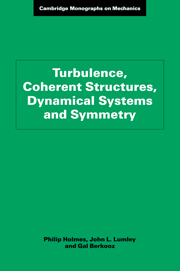12 - Review: prospects for rigor
Published online by Cambridge University Press: 03 February 2010
Summary
As we near the end of our story, the reader will now appreciate that there are many steps in the process of reducing the Navier–Stokes equations to a low-dimensional model for the dynamics of coherent structures. Some of these involve purely mathematical issues, but most require an interplay among physical considerations, judgement, and mathematical tractibility. While our development of a general strategy for constructing low-dimensional models has been based on theoretical developments such as the POD and dynamical systems methods, the general theory is still sketchy and, in specific applications, many details remain unresolved.
The mathematical techniques we have drawn on lie primarily in probability and dynamical systems theory. In this closing chapter we review some aspects of the reduction process and attempt to put them into context. Some prospects for rigor in the reduction process are also mentioned. This is by no means a comprehensive review or discussion of future work; instead, we have chosen to highlight a few recent applications of dynamical and probabilistic ideas to illustrate lines along which a general theory might be further developed.
We start by discussing some desirable properties for low-dimensional models, and criteria by which they might be judged. We then outline in Section 12.2 an a priori short-term tracking estimate which describes, in a probabilistic context, how rapidly typical solutions of the model equations are expected to diverge from those of the full Navier–Stokes equations restricted to the model domain.
- Type
- Chapter
- Information
- Turbulence, Coherent Structures, Dynamical Systems and Symmetry , pp. 376 - 400Publisher: Cambridge University PressPrint publication year: 1996



